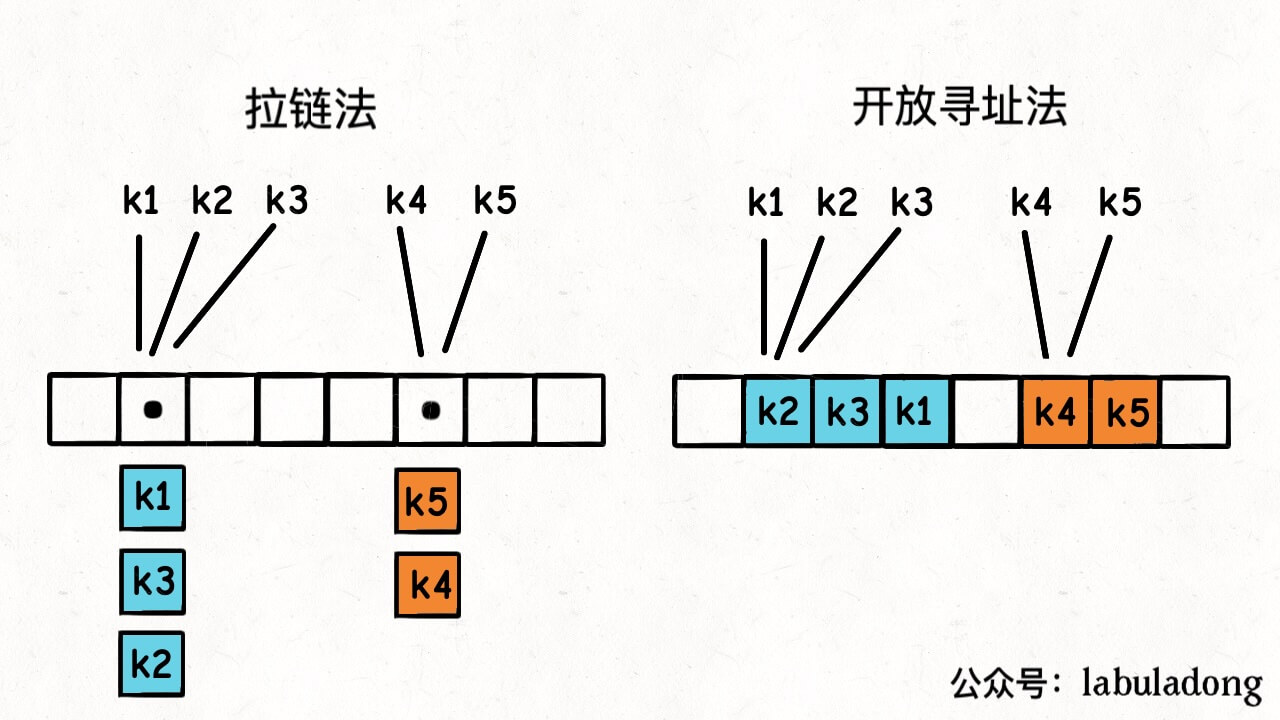Hash Map
Core Concept
Mapis an interface in Java.public interface Map<K, V> {
boolean containsKey(Object key);
V get(Object key);
V put(K key, V value);
}- The underlying data structure of
HashMapis an array. - Key is unique but value can be duplicated as index of array is unique.
Hash function
- To convert an input of arbittrary lenght (key) into a fixed-length output (index).
- Used to calculate the index of array. If the hash function has a complexity of
O(n), the performance of such as adding, deleting, searching will be degrade toO(n). - Must produce the same output for the same input.
Hash Collision
- If two keys produce the same index, they are called hash collision.
- Cannot be avoided because the hash function maps an infinite space of keys to a finite space of indexes.
- Approaches:

- Chaining Method
- When multiple keys collide, store them in a linked list.
- For finding the key, you need to traverse the linked list with a time complexity of
O(K), where K is the length of the key.
- Linear Probing Method (also called open addressing)
- When a key collides, find the next empty slot, normally
index + 1. If that's also occupied, it keeps moving forward until it finds an empty slot. - If the stored key is not in the calculated index (
index = hash(key). You need to continue checking the subsequent indices until you find the key or an empty slot with a time complexity ofO(K), where K is the length of the key.
- When a key collides, find the next empty slot, normally
- Chaining Method
- Why do hash collisions occur frequently?
- A poorly desiged hash function leads to uneven distribtion of hash values, causing many keys to map to the same index.
- The hash table contains too many key-value pairs, making collisions unavoidable even with a perfect hash function.
Load Factor & Resizing
- While the chaining method and linear probing method can resolve hash collisions, they lead to performance degradation.
- Load factor measure how full a hash table is.
- Formula:
size / table.length, where size is the number of key-value pairs in the hash table. - When the number of elements in the hash table exceeds the load factor, the hash table is resized and re-hashed. In Java's HashMap, the default load factor is 0.75.
Why Can't Rely on the Traversal Order of Hash Table?
- The traversal order of a hash table is not guaranteed.
- The hash function distributes your keys unevenly to the underlying array.
- The keys need to be rehashed when the hash table is resized (expand or shrink)., the index where a key is stored may change.
Why Not Recommend to Add/Delete Hash Tabke Keys in a For Loop?
- Resizing (expansion or contraction) causes changes in hash values.
- If you add or delete elements while traversing, and halfway through the traversal an insertion or deletion triggers resizing, the entire table array changes.
Key Must Be Immutable
-
Only immutable keys can be used as keys in a hash table.
-
An immutable types is an object whose state cannot be changed once it is created. For example, in Java, types like
StringandIntegerare immutable. -
Mutable types are not recommended for use as keys:
- The
hashCode()ofArrayListlike:Pseudo codeint hashCode() {
int h = 1;
for (int i = 0; i < elementData.length; i++) {
h = 31 * h + elementData[i];
}
return h;
}- Issues:
- Efficiency: Calculating the
hashCode()requires iterating over all elements in the list. The complexity of this operation isO(n), where n is the number of elements in the list. - Hash Code Change: The
hashCode()value of a list may change if the list is modified.- For example, suppose you use an
ArrayListvariablearras a key to store a coresponding value. Ifarr's elements are modified, itshashCode()value changes. When you query the hash table again witharr, you will find no value.
- For example, suppose you use an
- Efficiency: Calculating the
- Issues:
- The
-
The
hashCode()method ofStringalso requires iterating over all characters in the string, but due to its immutability, the value can be computed once and cached. This results in an average time complexity ofO(1).
Variation: LinkedHashMap
- Maintains the insertion order of keys, without affecting the time complexity of the hash table's add, delete, search operations, and without being impacted by resizing.
- By linking all key-value pairs using linked list structure, maintaining references to a
headandtailnode. - Each time a new key is inserted into the
tablearray, we append that key to the tail of the linked list.
class Node {
String key;
String value;
Node prev;
Node next;
Node(String key, String value) {
this.key = key;
this.value = value;
}
}
HashMap<String, Node> map = new HashMap<>();
String key = "k1";
String value = "v1";
map.put(key, new Node(key, value));
- The underlying method handles the hash collsion, so no need to care at this moment.
- Search a node by key: get method of hash table is
O(1), and getting the value associated with the node isO(1). - Insert a new key-value pair: hash table's insertion is
O(1), the insertion at the head or tail of the doubly linked list's insertion is alsoO(1). Thus,O(1). - Delete a key: hash table's deletion is
O(1), and removing a node from the doubly linked list is alsoO(1). Thus,O(1).